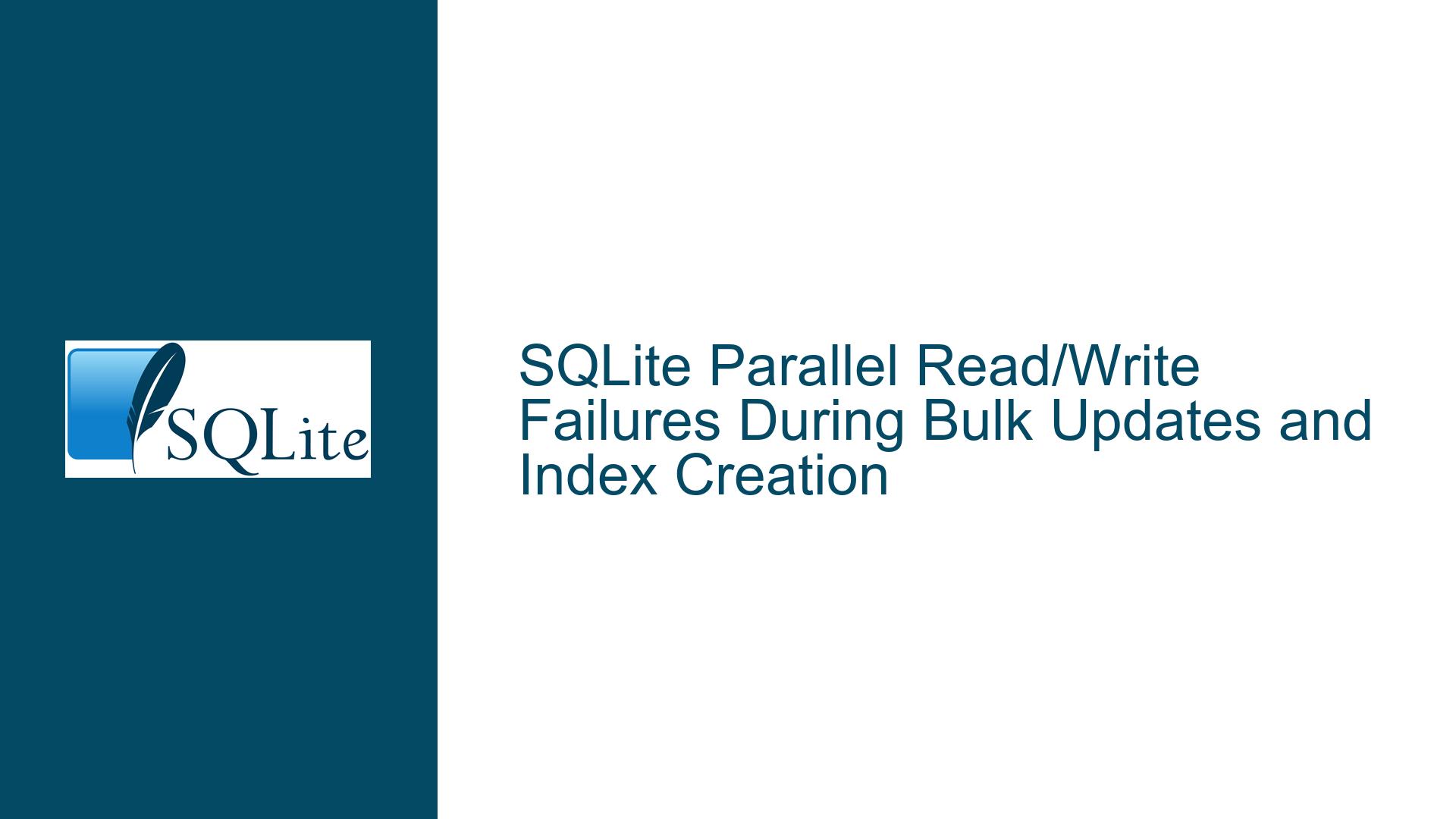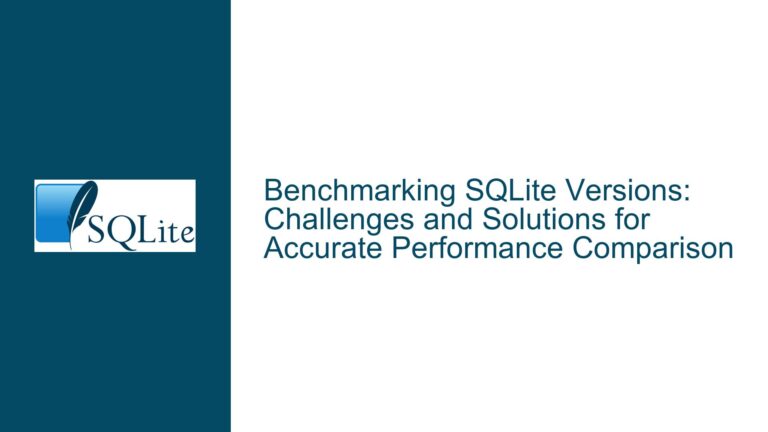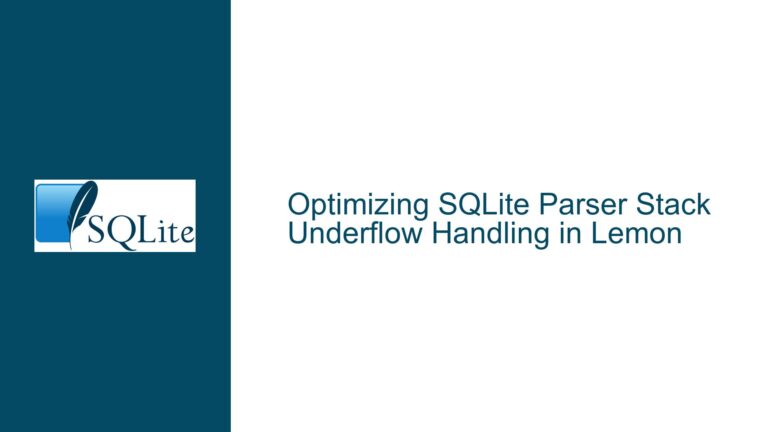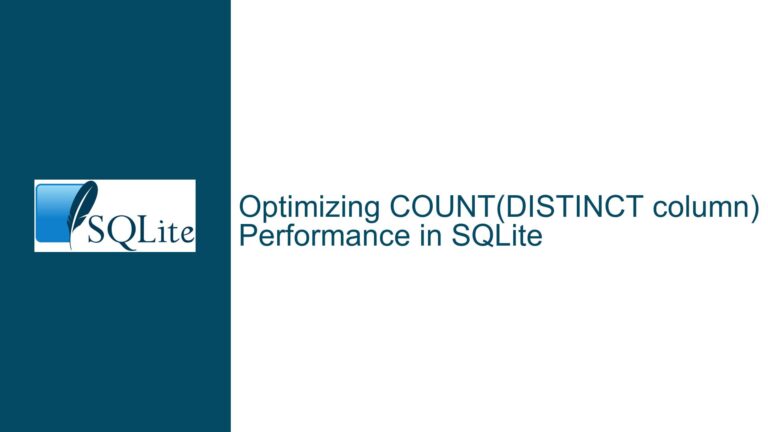SQLite Parallel Read/Write Failures During Bulk Updates and Index Creation
Parallel Read Failures During Bulk Updates with Separate Threads
In scenarios where an application employs multiple threads to interact with an SQLite database—one for bulk updates and another for critical read operations—read failures can occur despite using separate database handles and the SQLITE_THREADSAFE=2 compilation option. The expectation is that read operations should succeed consistently, especially when the database is configured to allow concurrent access. However, in practice, read operations fail approximately 98% of the time during bulk updates, only succeeding when a SELECT COUNT query is executed within the update loop. This behavior is counterintuitive and problematic, particularly when the application requires read operations to complete within a strict one-second response time.
The root of this issue lies in the interplay between SQLite’s locking mechanisms, transaction handling, and the specific configuration of the database. SQLite’s default locking behavior, even with SQLITE_THREADSAFE=2, does not inherently guarantee that read operations will succeed during concurrent writes. The SQLITE_THREADSAFE=2 option merely disables internal mutexes, relying on the application to enforce thread safety. This setting does not influence the database’s locking or concurrency behavior. Furthermore, the use of sched_yield() to prioritize the read thread is ineffective because SQLite’s locking mechanism operates independently of the thread scheduler.
The failure of read operations during bulk updates is exacerbated by the absence of a busy timeout or an improperly configured one. Without a busy timeout, read operations may immediately fail when encountering a locked database, rather than waiting for the lock to be released. Additionally, the database’s cache size and journal mode play significant roles in determining the success of concurrent operations. A small cache size can lead to frequent disk I/O, increasing the likelihood of contention between read and write operations. Similarly, the default rollback journal mode can cause write operations to block reads during transaction commits, further reducing the chances of read success.
WAL Mode and Busy Timeout Configuration as Key Factors
The primary factors contributing to read failures during bulk updates are the database’s journal mode and the absence or misconfiguration of a busy timeout. SQLite’s Write-Ahead Logging (WAL) mode is designed to improve concurrency by allowing reads to proceed concurrently with writes. However, this mode is not enabled by default, and its benefits are often overlooked. In WAL mode, writes are appended to a separate log file, allowing reads to access the main database file without being blocked by write operations. This significantly reduces contention between read and write threads, improving the likelihood of read success.
Another critical factor is the busy timeout configuration. SQLite provides a busy timeout mechanism that allows operations to wait for a specified period before failing when the database is locked. Without a busy timeout, read operations may fail immediately if the database is locked by a write operation. Setting an appropriate busy timeout ensures that read operations retry for a reasonable duration, increasing their chances of success. However, the busy timeout must be configured correctly, as an excessively long timeout can delay critical read operations, while a too-short timeout may not provide sufficient time for the lock to be released.
The cache size also plays a role in determining the success of concurrent operations. A small cache size can lead to frequent disk I/O, increasing the likelihood of contention between read and write operations. Increasing the cache size can reduce the frequency of disk I/O, allowing more operations to be performed in memory and reducing contention. However, this must be balanced against the available system memory, as an excessively large cache size can lead to memory exhaustion.
Finally, the use of BEGIN IMMEDIATE transactions can help reduce contention by informing the database that a transaction intends to perform write operations. This allows the database to acquire the necessary locks upfront, reducing the likelihood of contention during the transaction. However, this approach must be used judiciously, as it can increase the duration of locks and potentially exacerbate contention.
Implementing WAL Mode, Busy Timeout, and Optimized Transactions for Consistent Reads
To achieve consistent read operations during bulk updates, several steps must be taken to optimize the database configuration and transaction handling. The first and most critical step is enabling WAL mode. This can be done by executing the following SQL command: PRAGMA journal_mode=WAL;. Enabling WAL mode allows read operations to proceed concurrently with writes, significantly reducing contention and improving the likelihood of read success. Additionally, setting the wal_autocheckpoint pragma to a reasonable value ensures that the WAL file is checkpointed regularly, preventing it from growing excessively large and consuming disk space.
The next step is configuring an appropriate busy timeout. This can be done using the sqlite3_busy_timeout() function, which sets the maximum time (in milliseconds) that an operation will wait for a lock to be released before failing. For example, setting a busy timeout of 2000 milliseconds (2 seconds) ensures that read operations retry for a reasonable duration, increasing their chances of success. However, the busy timeout must be balanced against the application’s response time requirements, as an excessively long timeout can delay critical read operations.
Increasing the cache size can also help reduce contention by allowing more operations to be performed in memory. This can be done using the PRAGMA cache_size command. For example, setting the cache size to 10000 pages (approximately 40 MB) can significantly reduce the frequency of disk I/O, allowing more operations to be performed in memory and reducing contention. However, the cache size must be balanced against the available system memory, as an excessively large cache size can lead to memory exhaustion.
Using BEGIN IMMEDIATE transactions can help reduce contention by informing the database that a transaction intends to perform write operations. This allows the database to acquire the necessary locks upfront, reducing the likelihood of contention during the transaction. For example, instead of using a plain BEGIN statement, use BEGIN IMMEDIATE to indicate that the transaction will perform write operations. This approach must be used judiciously, as it can increase the duration of locks and potentially exacerbate contention.
Finally, optimizing the bulk update process can help reduce contention and improve the likelihood of read success. Instead of performing all updates in a single transaction, break the updates into smaller batches and commit each batch separately. This reduces the duration of locks and allows read operations to proceed between batches. For example, instead of updating 250,000 records in a single transaction, update 250 records per transaction and commit each batch separately. This approach reduces the duration of locks and allows read operations to proceed between batches, improving the likelihood of read success.
In cases where index creation blocks other operations, consider creating indexes in a separate database file. This allows other operations to proceed concurrently, as each database file has its own lock. For example, instead of creating an index on Table 1 while performing updates on Table 2 in the same database file, create the index in a separate database file. This allows updates on Table 2 to proceed concurrently with index creation on Table 1, reducing contention and improving the likelihood of read success.
By implementing these optimizations, it is possible to achieve consistent read operations during bulk updates, even in a highly concurrent environment. Enabling WAL mode, configuring an appropriate busy timeout, increasing the cache size, using BEGIN IMMEDIATE transactions, and optimizing the bulk update process can significantly reduce contention and improve the likelihood of read success. Additionally, creating indexes in a separate database file can allow other operations to proceed concurrently, further reducing contention and improving performance.
| Configuration/Optimization | Description | Impact |
|---|---|---|
| WAL Mode | Enables concurrent reads and writes by using a write-ahead log. | Reduces contention between read and write operations. |
| Busy Timeout | Sets the maximum time an operation will wait for a lock. | Increases the likelihood of read success by allowing retries. |
| Cache Size | Increases the number of pages cached in memory. | Reduces disk I/O and contention by performing more operations in memory. |
| BEGIN IMMEDIATE | Informs the database that a transaction will perform write operations. | Reduces contention by acquiring locks upfront. |
| Batch Updates | Breaks bulk updates into smaller batches and commits each batch separately. | Reduces the duration of locks and allows read operations to proceed between batches. |
| Separate Database Files | Creates indexes in a separate database file. | Allows other operations to proceed concurrently with index creation. |
By carefully configuring and optimizing the database, it is possible to achieve consistent read operations during bulk updates, even in a highly concurrent environment. These optimizations not only improve the likelihood of read success but also enhance overall database performance and reliability.






